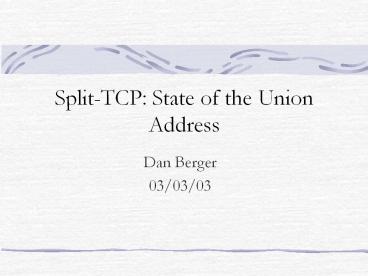Split-TCP:%20State%20of%20the%20Union%20Address PowerPoint PPT Presentation
Title: Split-TCP:%20State%20of%20the%20Union%20Address
1
Split-TCP State of the Union Address
- Dan Berger
- 03/03/03
2
Adgenda
- Proxied or Split TCP Conceptual Overview
- Previous Investigation
- Current Work
- Results and Analysis
- Conclusion
3
Conceptual Overview
- The Problem(s)
- TCP cant distinguish link failure from
congestion. - Results in lowered throughput
- Effect is magnified on longer (hop-count)
connections
4
Concepts (Cont.)
- The Proposal
- Designate nodes along the path to be packet-level
proxies. - These proxies buffer segments until theyve been
received (and acknowledged) by the next proxy (or
destination) - If the packet isnt ackd in reasonable time
they resend.
5
Details, Details
- Proxy selection must be distributed and dynamic,
to accommodate mobility in the network. - The proxies should be as stateless as possible
specifically, keeping per-flow state is bad.
6
Previous Investigation
- In a simple string topology Split-TCP is able to
provide a better overall throughput than TCP, up
to about 15 - In a complex topology with mobility, the total
throughput improves with the use of proxies by
about 5 to about 30
7
Current Work
- The initial goal was to implement a linux kernel
implementation. - This work was stymied by a lack of detailed
understanding of the desired behavior of the
protocol. - Work done last quarter found issues with the
current simulation model which suggested it
needed to be revisited.
8
Forward, march!
- We decided to turn our attention to building a
more accurate and usable simulation model in ns. - The specific issues in the existing model we
wanted to address were - Lack of end-to-end window management
- Lack of dynamic proxy selection
9
Proxy-To-Proxy Window Mgmt.
- The initial simulation model literally decomposed
a long TCP connection into multiple shorter
connections. - This had undesired (and unforeseen) consequences.
10
Static Proxy Selection
- Additionally, this decomposition was done using
global routing knowledge. - To accommodate mobility, the proxy selection code
was re-run periodically. - This meant that new TCP connections were
established, and the old ones allowed to drain.
11
The New Model
- The new simulation model consists of three
components - SplitTCPSource
- SplitTCPWedge
- SplitTCPSink
- The Source and Sink are simply specializations of
TCPSource and TCPSink, respectively.
12
SplitTCPWedge
- In order to perform dynamic proxy selection, one
needed to be able to inspect each packet received
by a node. - Then the decision to proxy can be based on
whatever criteria seem appropriate. - All Split-TCP enabled nodes run the wedge code.
13
An Anonymous NS Node
14
Better, Stronger, Faster
SplitTCPWedge
15
Model Summary
- This new simulation model uses a TCP session
established between the source and target, and
dynamic proxy selection is performed along the
path.
s
t
16
End-To-End Window Mgmt.
- The TCP session performs window management as
usual but control can be tweaked both manually
as well as by the Wedge. - For instance, end-to-end ACKs can be skipped, the
congestion window can be managed based on
inter-proxy ACKs, etc.
17
Proxy Selection
- Each node decides, independently, (currently
based on hops since last proxy and their current
backlog) if they should proxy a packet. - Proxying does not keep per-flow state.
- Retransmissions are scheduled based on the
current inter-proxy round trip time estimate.
18
Results
- Current simulations show a ? 10 degradation in
throughput vs. Standard TCP. - With parameter tweaking, this degradation varies,
but Split TCP never equals standard TCP.
19
Analysis
- One identified cause of the dramatically
different behavior of the old and new simulation
models relates to out-of-order packet delivery. - In the old model, the packet stream was
reassembled at each proxy and bytes were only
forwarded once they arrived in order. - Per-flow state at each proxy.
- In the new model, this is not the case.
20
Parameterization
- By tuning various parameters including initial
congestion window, window growth factors, etc
the throughput of Split TCP can be improved. - There are over 150 tuning parameters in the
stock NS TCP code. If they were all just
binary parameters thats still 2150 possible
configurations!
21
Conclusion
- Were trying to determine rational next steps
- Do we continue the search for the magic set of
parameters? - Do we examine the behavior of the new model in
scenarios with mobility? - Few answers, many more questions.

